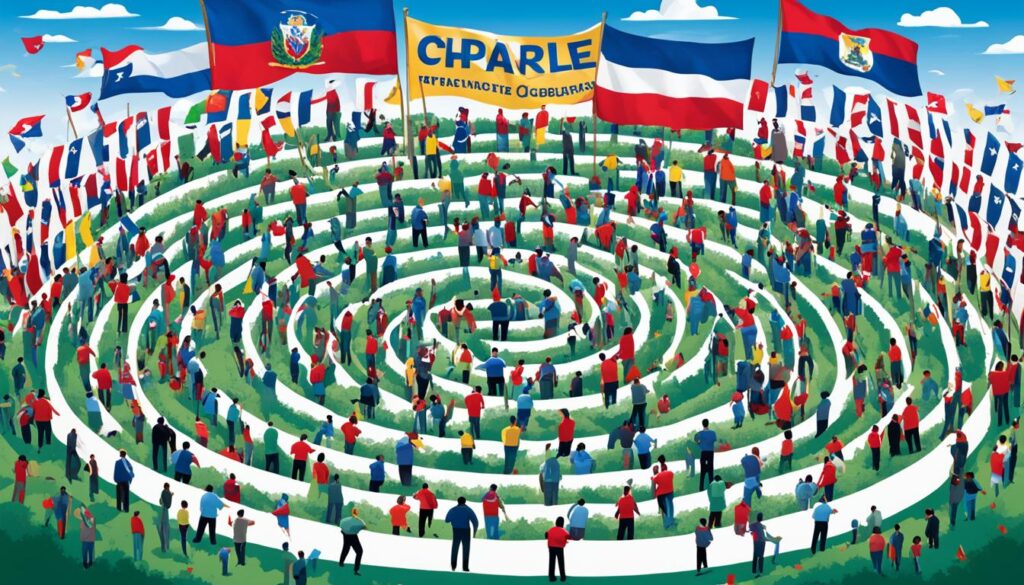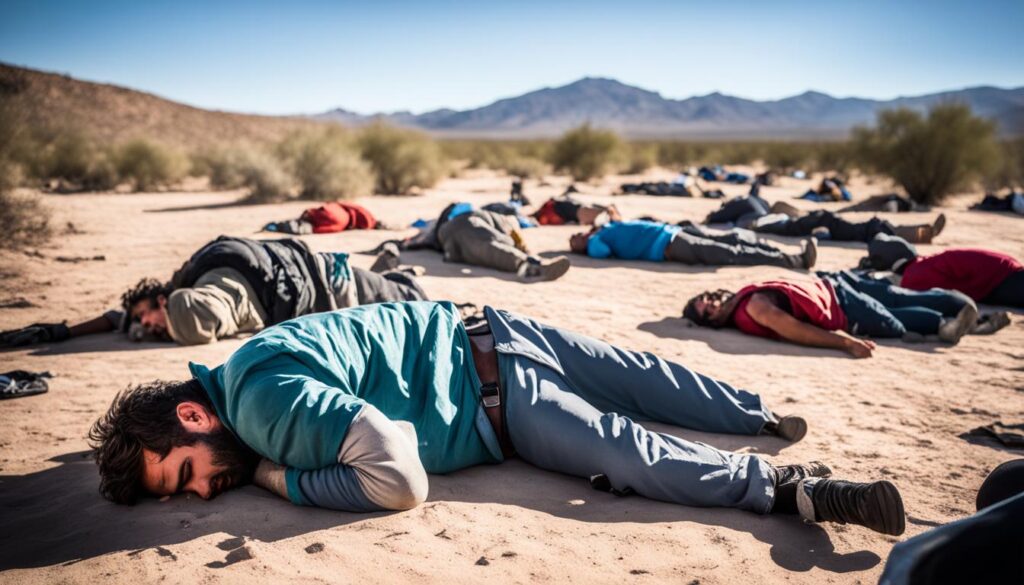The Cuban Family Reunification Parole (CFRP) Program started in 2007. It helps U.S. citizens and lawful permanent residents bring their family members from Cuba to the U.S. This program lets approved parolees come to the U.S. without waiting for their immigrant visas.
As of August 11, 2023, there have been updates to the CFRP program. Now, forms I-131 for initial CFRP applications are not accepted anymore. But, add-on derivative beneficiaries can still use Form I-131 to ask for parole.
To get parole, the petitioner must be a U.S. citizen or lawful permanent resident. They also need an approved Form I-130, Petition for Alien Relative. After getting their I-130 approved, they will get an invitation from the Department of State’s National Visa Center. This invitation shows they are eligible for the CFRP program.
Keep up with the latest news on the approved parole list in Cuba today. Check our website for more info and resources on the Cuba Parole Program.
Eligibility Under the Form I-131 CFRP Process
To be eligible for the Form I-131 CFRP process, you must meet certain requirements. Let’s go through the eligibility criteria:
- U.S. Citizen or Lawful Permanent Resident: The petitioner must be a U.S. citizen or lawful permanent resident who has filed Form I-130 for a Cuban family member. This form needs to be approved by USCIS.
- Cuban Family Member: The beneficiary must be a Cuban national and the recipient of the approved Form I-130.
- Immigrant Visa Availability: The immigrant visa should not yet be available for the relative. This means that the Cuban family member is not currently eligible to apply for the immigrant visa.
- Background Checks and Medical Examination: Eligibility also depends on passing background checks and a medical examination. These checks ensure that the applicant meets the admissibility requirements for entry into the United States.
- Discretionary Factors: Discretionary factors are also taken into consideration during the eligibility process. They include factors such as family ties, humanitarian concerns, and contributions to the community.
Overall, meeting the eligibility requirements for the Form I-131 CFRP process is crucial for successfully obtaining parole for your Cuban family members. It’s essential to follow the necessary steps and provide the required documentation to increase your chances of approval.
| Eligibility Requirements |
|---|
| U.S. Citizen or Lawful Permanent Resident |
| Cuban Family Member |
| Immigrant Visa Availability |
| Background Checks and Medical Examination |
| Discretionary Factors |
Note: Meeting the eligibility requirements does not guarantee approval. The decision is ultimately at the discretion of the USCIS and other relevant authorities.
Who Is Eligible
To be eligible for the Cuban Family Reunification Parole (CFRP) program, you must meet certain requirements. You must be either a U.S. citizen or a lawful permanent resident. You also need to have filed Form I-130 for a Cuban family member and gotten USCIS approval.
You also need an invitation from the National Visa Center (NVC) to join the CFRP program. This invitation shows you’re eligible to move forward.
CFRP is for immediate family members of the petitioner, like spouses and kids under 21 who are not married. The Cuban family member must have an approved Form I-130.
Not everyone can join CFRP, even if they meet the basic requirements. Serious crimes or failing a background check can make you ineligible. Also, if you can’t go to an interview in Cuba, you won’t qualify.
To sum up, you need to be a U.S. citizen or lawful permanent resident. You must have an approved Form I-130 for a Cuban family member and get an NVC invitation. Meeting these criteria is key for a successful CFRP process.
CFRP Eligibility Requirements:
| Requirement | Description |
|---|---|
| U.S. Citizen or Lawful Permanent Resident | The petitioner must be either a U.S. citizen or a lawful permanent resident. |
| Approved Form I-130 for a Cuban Family Member | The petitioner must have filed Form I-130 for a Cuban family member and received approval from USCIS. |
| National Visa Center Invitation | The petitioner must have received an invitation from the National Visa Center to participate in the CFRP program. |
| Immediate Relatives | The program is open to spouses and unmarried children under the age of 21 of the petitioner. |
| Approved Form I-130 for the Cuban Family Member | The beneficiary must be the recipient of an approved Form I-130. |
| Exceptions | Individuals who have committed serious crimes, failed background checks, or are unable to attend an in-person interview in Cuba are not eligible for CFRP. |
Spouses and Unmarried Children under Age 21 of the Principal Beneficiary (Derivative Beneficiaries)
If the main person has a spouse and kids under 21, they are also part of the approved Form I-130. They can also get parole under the CFRP process if they qualify.
When asking for parole for the main person, you must also ask for it for their spouse and kids under 21. This makes sure they can come to the United States with the main person.
But, if the main person didn’t file for CFRP or is not eligible, their family won’t get parole under CFRP either.
It’s key to follow the right steps and send all needed documents. This helps increase the chance of getting parole for the main person and their family.
Benefits of CFRP for Derivative Beneficiaries
CFRP lets derivative beneficiaries join their main person in the United States. This keeps families together and helps them start a new life safely. Parole gives them temporary entry and offers benefits like:
- Access to work authorization
- Enrollment in educational institutions
- Access to healthcare services
- Ability to apply for a Social Security Number
This makes the immigration process easier for families. It helps the main person and their family settle into American life better.

| Eligibility Criteria for Derivative Beneficiaries | Requirements |
|---|---|
| Relationship to the Principal Beneficiary | Spouse or unmarried child under age 21 |
| Approval of Form I-130 | Derivative beneficiaries must be listed on the approved Form I-130 for the principal beneficiary |
| Filing the Form I-131 CFRP Application | A parole request for derivative beneficiaries should be filed simultaneously with the request for the principal beneficiary |
| Principal Beneficiary’s Ineligibility | If the principal beneficiary is deemed ineligible for CFRP, derivative beneficiaries will not be eligible for parole under CFRP |
Requesting to Add a Spouse or Child to an Approved Form I-130 (Add-on Derivative Beneficiaries)
If you’re the main beneficiary and you’ve gotten married or had a child, you can add your spouse or child to your approved Form I-130. This lets your loved ones come to or join you in the United States.
Form I-131 CFRP Application
To add an add-on derivative beneficiary, you must file a Form I-131 CFRP application. Make sure to note “CFRP ADD-ON” at the top of the form. This shows it’s for an add-on derivative beneficiary.
This form helps get the travel documents your spouse or child needs to enter or re-enter the United States. They will be seen as dependents of the main beneficiary.
Exemption from Filing Fee
Since December 13, 2023, there’s no fee for filing Form I-131 for add-on derivative beneficiaries. This rule helps ease financial stress and helps families be together.
| Document Checklist | Description |
|---|---|
| Proof of Marriage | Submit a marriage certificate to prove the relationship between the main beneficiary and the spouse. |
| Birth Certificate | Give the child’s birth certificate to show the family link between the main beneficiary and the child. |
| Passport Photos | Include passport-size photos of the spouse and child as per the Form I-131 instructions. |
| Principal Beneficiary’s Approval Notice | Attach a copy of the Form I-130 approval notice the main beneficiary got. It shows the petition is valid. |
| Form I-131 CFRP Application | Fill out and sign the Form I-131 CFRP application. Mark it as for an add-on derivative beneficiary. |
Processes for Cubans, Haitians, Nicaraguans, and Venezuelans (CHNV)
The Biden-Harris Administration has set up parole processes for Cubans, Haitians, Nicaraguans, and Venezuelans (CHNV). This is to give them lawful ways to come to the U.S. and reduce the number of people migrating irregularly. These processes let people from these countries get legal status and work in the U.S. safely and legally.
To get CHNV parole, people must meet certain requirements. They need a financial supporter in the U.S., pass background checks, and meet other rules. If they get approved, they can work and live in the U.S. legally during their stay.
CHNV parole has greatly reduced irregular migration and the number of people crossing the border illegally. It gives people a legal way to come to the U.S. This makes it less tempting for people to risk their lives by using smugglers.

CHNV Parole Processes: Key Points
- Designed to provide lawful pathways and reduce irregular migration
- Eligibility criteria include a U.S.-based financial supporter and passing vetting checks
- Approved individuals may be granted parole and work authorization
- Significantly reduces unlawful border encounters
- Counters the exploitation of individuals by smuggling networks
The CHNV parole processes show the administration’s effort to tackle irregular migration legally. They offer a safer way for people from Cuba, Haiti, Nicaragua, and Venezuela to come to the U.S. legally. This approach keeps migrants safe and helps create a fair immigration system.
| Country | Eligible Individuals per Month |
|---|---|
| Cuba | 10,000 |
| Haiti | 10,000 |
| Nicaragua | 5,000 |
| Venezuela | 5,000 |
Lawful Pathways Work
Since June 2023, nearly 160,000 people have come to the U.S. through lawful pathways. This includes over 38,000 Cubans, more than 63,000 Haitians, over 29,500 Nicaraguans, and over 58,000 Venezuelans.
To join these pathways, people need to fill out Form I-134A. They must show they can support the migrants financially and pass a background check. This makes sure migrants have enough money and are checked thoroughly before coming to the U.S.
These lawful paths help CHNV nationals and make coming to the U.S. safe and orderly. They check everyone’s background to lower the risk of illegal migration. This way, those who really need help can get it.
Consequences of Irregular Migration
There are consequences for irregular migration, including a minimum 5-year re-entry bar and prosecution for repeat offenders.
Moving without legal permission is hard for both the migrants and the countries they’re moving to. Those who try to come illegally might face legal trouble and could have a hard time getting legal status later. The 5-year ban on re-entry is meant to stop people from moving illegally.
Choosing legal ways to move avoids the dangers of moving illegally. These dangers include being exploited, falling into human trafficking, and risking dangerous journeys. The checks during legal pathways add more safety for everyone.

There are Consequences to Irregular Migration
Trying to enter a country without the right papers can lead to big problems. These issues can affect migrants and their families in many ways.
One big issue is a 5-year ban on coming back. If caught, you might not be allowed to enter for five years. This can cause a long separation from family and make it hard to work, study, or fit in.
Irregular migration also means you might lose your chance for legal entry. Countries have rules for coming in legally. But if you go the wrong way, you might not get to follow these rules anymore.
Smuggling is another big problem with irregular migration. Smugglers make money by helping people cross borders illegally. They charge a lot and put migrants in danger. If caught, migrants could face serious legal trouble.
Trying to sneak into places like Panama, Mexico, or the U.S. can also make you ineligible for legal help. You won’t be able to use the legal ways to stay. Instead, you might face action from immigration authorities.
Some groups face even more hurdles. Kids without adults might find it hard to get help. Cubans or Haitians stopped at sea after certain dates might also struggle to get legal status.
“Irregular migration has big risks like re-entry bans, losing legal ways to stay, and being taken advantage of by smugglers. It’s important to know these dangers and look for legal ways to move safely.”

| Consequences of Irregular Migration | Key Points |
|---|---|
| Minimum 5-year bar on re-entry | Limits ability to legally return |
| Loss of eligibility for lawful pathways | Makes legal migration more challenging |
| Smuggling and exploitation | Risks and potential criminal consequences |
| Ineligibility for parole processes | Limits access to established pathways |
| Additional restrictions for certain groups | Children traveling without parents, interdicted Cuban or Haitian nationals |
DHS is Calling on Partners to Help Migrants Avoid Exploitation
The Department of Homeland Security (DHS) knows how crucial it is to protect migrants as they go through the parole process. They want to make sure those coming to the United States are safe. So, DHS is asking for help from supporters and partners to stop exploitation and scams.
If you want to help, check out the USCIS website for details on how to fill out Form I-134A, the Affidavit of Support. It’s free to be a supporter and can really change someone’s life. It’s a chance to help those who want to come to the U.S.
USCIS also has tips on spotting and avoiding scams. It’s important to stay alert and keep people safe from fake activities. Following these tips helps protect migrants and keeps their path to the U.S. legal and safe.
For more info on protecting migrants and legal ways to come to the U.S., visit the movilidadsegura.org website. This site has lots of useful info and advice for those going through the parole process. It’s a great resource for supporters and those applying for legal entry into the country.
Maintaining Fairness in the Monthly Selection
DHS makes sure the parole process is fair by looking at the filing date and processing cases in the order they were received. This way, everyone has a fair shot at being admitted. It helps avoid any unfair treatment.
The selection process looks at each case carefully, focusing on timely applications. DHS is dedicated to being fair and just in the parole process.
Conclusion
The parole processes in Cuba, like the Cuban Family Reunification Parole (CFRP) Program and the CHNV parole processes, help people move to the United States legally. They let eligible individuals join their families and work in the U.S. if they qualify.
But, it’s important to know the rules and follow them. Trying to come to the U.S. illegally can lead to big problems. You might get taken advantage of by smugglers and risk a dangerous journey.
The Department of Homeland Security (DHS) and its partners work hard to keep migrants safe. They aim to protect and help them during the parole process. By working together, we can make sure immigration is safe and fair, stopping people from being taken advantage of.
In short, the parole processes in Cuba give people a legal way to come to the U.S. and be with their families. By sticking to the rules, you can build a better life in the U.S. without the risks of illegal migration. We urge everyone who can apply to look into these processes and get advice from the right sources to make it through smoothly.